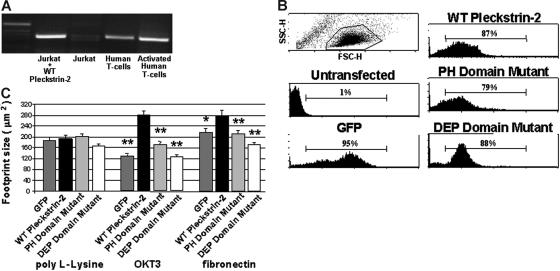Figure 2.
Expression of pleckstrin-2 in Jurkat cells increases cell spreading upon stimulation of cell-surface receptors. (A) RT-PCR products using primers to pleckstrin-2 were derived from Jurkat cells and human T cells and analyzed by agarose electrophoresis. Lane 1, 1 kb ladder; lane 2, Jurkat cells transfected with wild-type (WT) pleckstrin-2; lane 3, untransfected Jurkat cells; lane 4, resting primary human T cells; lane 5, human T cells activated with antibodies to CD3 and CD28. (B) Flow cytometry was performed on Jurkat cells transfected with plasmids that direct the expression of GFP (GFP), GFP fused to the amino-terminus of pleckstrin-2 (WT pleckstrin-2), or GFP fused to the amino-terminus of pleckstrin-2 containing point mutations in both PH domains, N13 N14 N256 (PH domain mutant), or in the DEP domain, N156 N157 N166 (DEP domain mutant). (C) Jurkat cells expressing GFP alone, WT pleckstrin-2, the PH domain mutant, or the DEP domain mutant were plated on either poly-L-Lysine, OKT3, or fibronectin. Images were captured and cell-footprint size was quantified using IP Lab imaging software. Shown is the mean ± SEM of 3 independent experiments. The paired Student t test was performed of the transfectants compared with WT pleckstrin-2 on each matrix. *P < .05; **P < .005.

